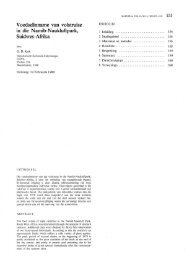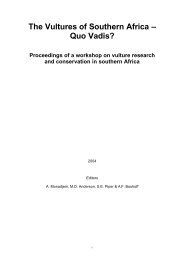Demarcation of Water Basins on National Level - EIS
Demarcation of Water Basins on National Level - EIS
Demarcation of Water Basins on National Level - EIS
Create successful ePaper yourself
Turn your PDF publications into a flip-book with our unique Google optimized e-Paper software.
Basin <str<strong>on</strong>g>Demarcati<strong>on</strong></str<strong>on</strong>g><br />
2.3.2. <str<strong>on</strong>g>Water</str<strong>on</strong>g> Supply and C<strong>on</strong>sumpti<strong>on</strong><br />
There are no bulk water schemes in the sub-basin and all villages and settlements are supplied by<br />
groundwater sources as well as from seas<strong>on</strong>ally water filled pans that spread over the area. Since<br />
independence a large number <str<strong>on</strong>g>of</str<strong>on</strong>g> water wells were drilled to supply the partly isolated villages and to<br />
date most <str<strong>on</strong>g>of</str<strong>on</strong>g> the populati<strong>on</strong> has access to safe drinking water. The main settlements, i.e. Ok<strong>on</strong>go,<br />
Omundaungilo and Ohumbulwa are supplied with groundwater from their own boreholes, operated by<br />
the Directorate Rural <str<strong>on</strong>g>Water</str<strong>on</strong>g> Supply, Ministry <str<strong>on</strong>g>of</str<strong>on</strong>g> Health and other Government instituti<strong>on</strong>s.<br />
The water is used for livestock farming and no irrigati<strong>on</strong> is taking place. There are, however,<br />
gardening projects planned in the sub-basin.<br />
2.3.3. Populati<strong>on</strong> Density and Political/Administrative Areas<br />
The sub-basin includes the Ok<strong>on</strong>go C<strong>on</strong>stituency and larger parts <str<strong>on</strong>g>of</str<strong>on</strong>g> the Epembe, Okankolo and<br />
Omundaungilo c<strong>on</strong>stituencies <str<strong>on</strong>g>of</str<strong>on</strong>g> the Ohangwena Regi<strong>on</strong>. The Ok<strong>on</strong>go Quarantine Camp, situated near<br />
the border to the Kavango Regi<strong>on</strong> is included into the sub-basin although being within the Okavango<br />
River catchment.<br />
2.3.4. Infrastructure, Socio-Ec<strong>on</strong>omic and Cultural Units<br />
There is no major infrastructure in the sub-basin and the populati<strong>on</strong> mainly makes a living from smallscale<br />
subsistence farming.<br />
2.3.5. Other<br />
The Ohangwena Kalahari Aquifer extends into Angola in the north, where the main groundwater<br />
recharge area is believed to exist in the upper catchments <str<strong>on</strong>g>of</str<strong>on</strong>g> the Omuramba Odila and the Cubango<br />
(Okavango) River. The proposed Niipele-Odila Sub-Basin committee should make an effort to co-opt<br />
authorities <str<strong>on</strong>g>of</str<strong>on</strong>g> the neighbouring Cuando-Cubango Province in Angola when discussing aquifer<br />
management and c<strong>on</strong>servancy measures.<br />
2.4 TSUMEB SUB-BASIN<br />
2.4.1. Physiographic Parameters<br />
The Tsumeb Sub-Basin is defined by the drainage <str<strong>on</strong>g>of</str<strong>on</strong>g> surface and groundwater from the Otavi<br />
Mountain Land in the south towards the Etosha Pan in the north. The boundary in the south is defined<br />
by the geological c<strong>on</strong>tact between the Basement rocks and the dolomitic arc <str<strong>on</strong>g>of</str<strong>on</strong>g> the Damara Sequence,<br />
which represents the recharge area <str<strong>on</strong>g>of</str<strong>on</strong>g> the Kalahari Aquifer underlying the Etosha Basin. The eastern<br />
boundary follows roughly the surface and groundwater divide between the Etosha and Okavango<br />
basins. The northern sub-basin margin is also defined by the surface and groundwater divide between<br />
the omiramba Niipele-Odila in the north and the omiramba Omuthiya-Owambo in the south. The<br />
Etosha Pan and its southern foreland are enclosed into the sub-basin.<br />
2.4.2. <str<strong>on</strong>g>Water</str<strong>on</strong>g> Supply and C<strong>on</strong>sumpti<strong>on</strong><br />
Groundwater is the main source <str<strong>on</strong>g>of</str<strong>on</strong>g> water supply in the sub-basin, as no major dams or pipeline routes<br />
exist. Bulk groundwater schemes are operated by the water utility Nam<str<strong>on</strong>g>Water</str<strong>on</strong>g> at Oshivelo, within the<br />
Etosha Nati<strong>on</strong>al Park and at Tsintsabis. The water supply <str<strong>on</strong>g>of</str<strong>on</strong>g> Tsumeb Town is managed by the<br />
Municipality. The Tsumeb Mine is dormant but groundwater is abstracted from the mineshaft and<br />
pumped into the municipal reticulati<strong>on</strong> system.<br />
Bittner <str<strong>on</strong>g>Water</str<strong>on</strong>g> C<strong>on</strong>sult 2004 GTZ, MAWRD<br />
6




